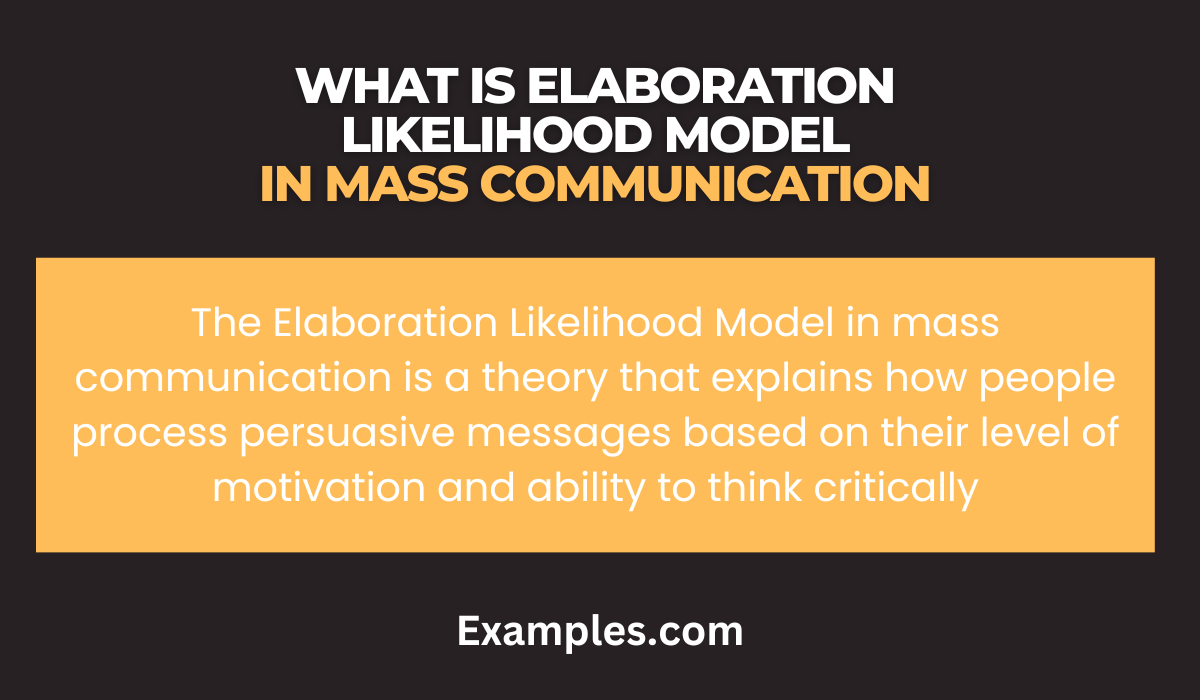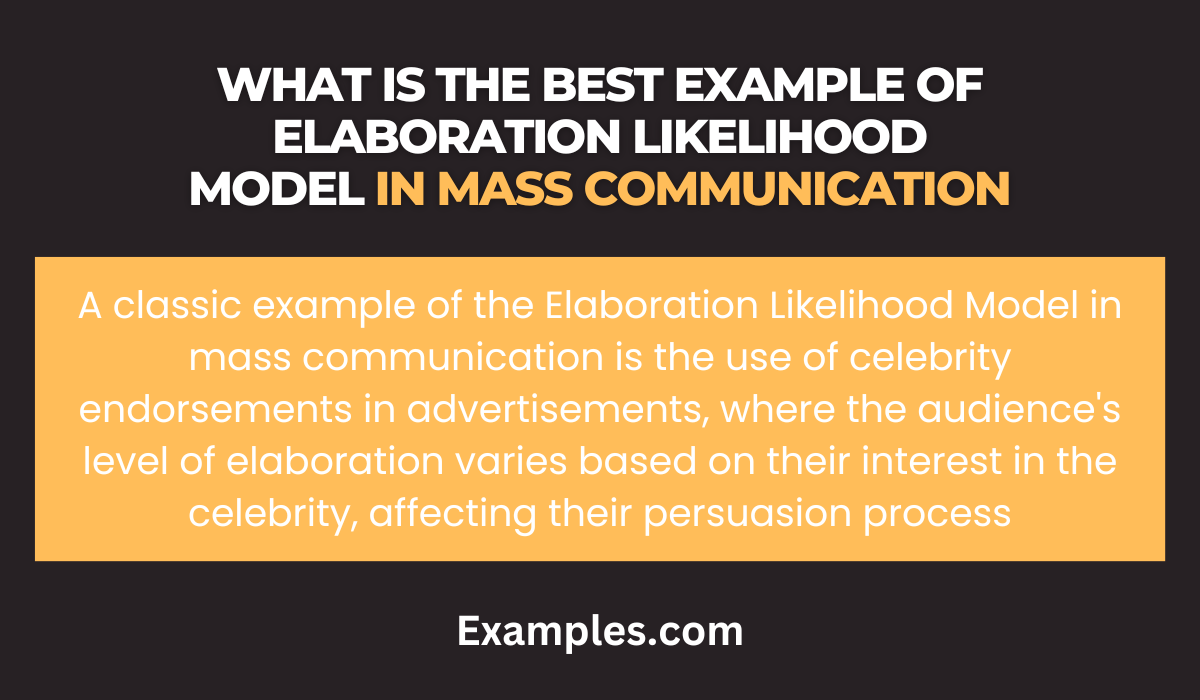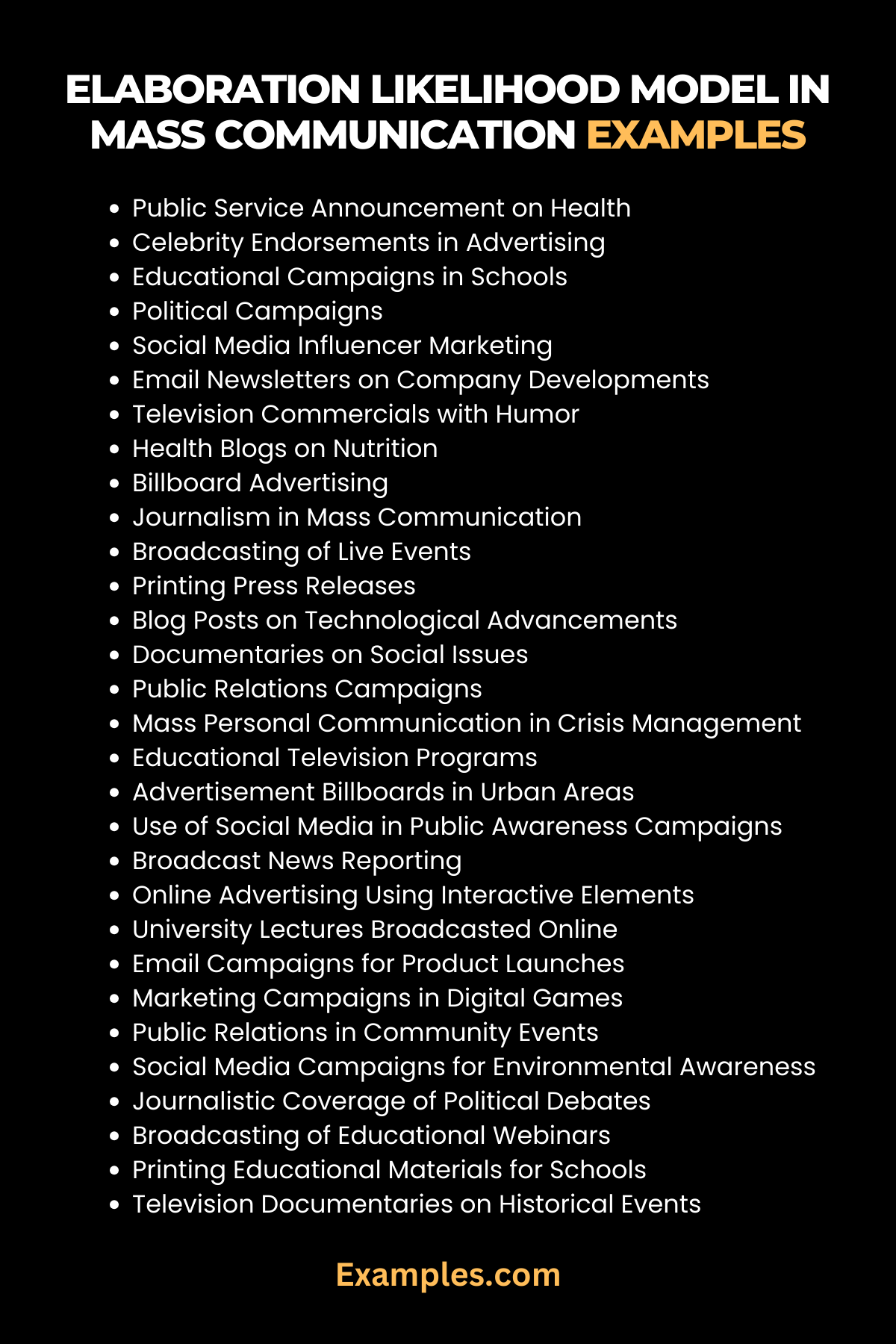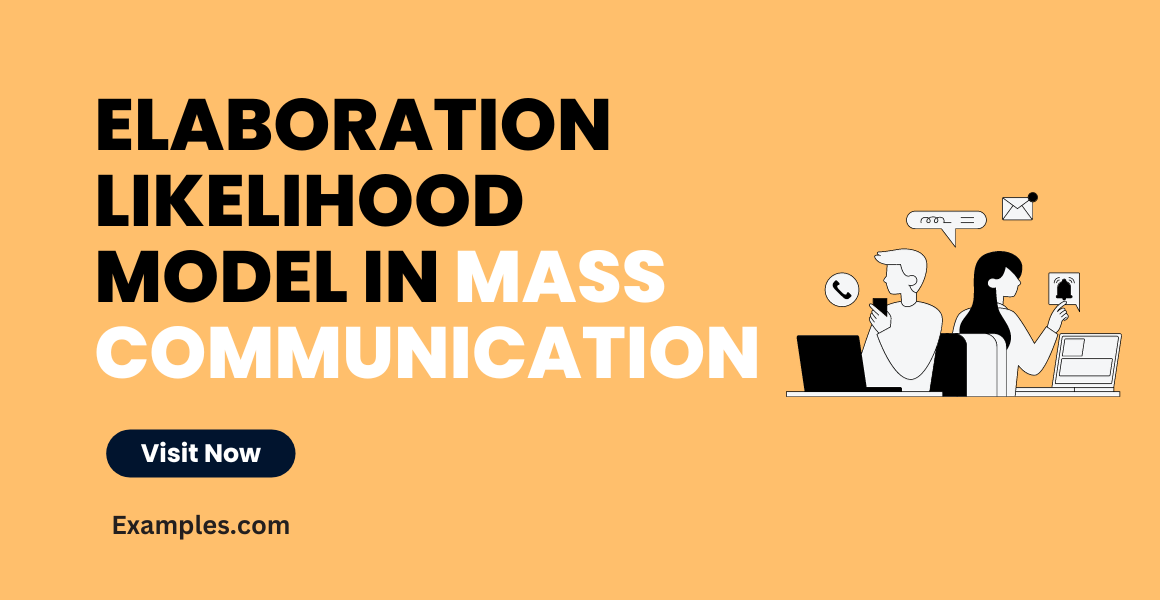29+ Elaboration Likelihood Model in Mass Communication Examples
In the dynamic field of mass communication, the Elaboration Likelihood Model plays a pivotal role in understanding how messages influence audiences. This comprehensive guide delves into the nuances of the model, especially its application in various Mass Communication Scenarios. Whether it’s in Journalism Mass Communication or digital platforms, this model sheds light on the cognitive processes behind message persuasion and impact. Exploring its principles provides invaluable insights for professionals and students alike, enhancing their grasp of effective communication strategies in today’s media-saturated world.
What is Elaboration Likelihood Model in Mass Communication
The Elaboration Likelihood Model (ELM) is a significant theory in Mass Communication that explains how individuals process and respond to persuasive messages. This model suggests that there are two primary routes of persuasion: the central route and the peripheral route. The central route involves thoughtful consideration of the arguments within the message. Here, individuals are influenced by the strength and quality of the arguments. In contrast, the peripheral route relies on superficial cues, such as the attractiveness or credibility of the source, rather than the content of the message itself.

History of Elaboration Likelihood Model in Mass Communication
Developed by Richard E. Petty and John Cacioppo in the 1980s, the Elaboration Likelihood Model revolutionized understanding of persuasion in Mass Communication. It emerged from the need to explain the varying results of persuasive communications and why different people respond differently to the same message. ELM provided a more nuanced approach, suggesting that the effectiveness of persuasion depends on the likelihood of individuals to elaborate, or carefully process, the message. It highlighted how factors like personal relevance, motivation, and ability to process a message influence the route of persuasion an individual might take.
What is the Best Example of Elaboration Likelihood Model in Mass Communication
A classic example of the Elaboration Likelihood Model in action can be seen in advertising campaigns. Consider a health campaign aimed at promoting a new fitness regimen. For individuals highly interested in health and fitness, the campaign’s detailed information about the regimen’s benefits (central route) would be persuasive. However, for those with less interest, the attractiveness of the model or the simplicity of the message (peripheral route) might be more influential. This example illustrates how the same message in a Mass Communication Scenario/Situation can be processed differently depending on the audience’s level of involvement and motivation to process the information.

30 Examples of Elaboration Likelihood Model in Mass Communication
The Elaboration Likelihood Model (ELM) plays a pivotal role in understanding the impact and effectiveness of Mass Communication. This theory explains how messages persuade and influence audiences. It highlights two routes of processing: central and peripheral. The central route involves deep, thoughtful analysis of content, making it vital in scenarios like public service announcements or educational campaigns. The peripheral route, on the other hand, relies on superficial cues like celebrity endorsements or attractive visuals, commonly seen in advertising.

- Public Service Announcement on Health: A central route example where detailed information about health risks and prevention methods are communicated. For instance, an anti-smoking campaign that provides scientific data about smoking’s harmful effects encourages the audience to process the information deeply.
- Celebrity Endorsements in Advertising: Utilizes the peripheral route. A famous actor endorsing a skincare product might persuade consumers based on the celebrity’s likability rather than the product’s features.
- Educational Campaigns in Schools: When schools use detailed facts and logical arguments to teach about environmental conservation, they engage students through the central route, promoting deeper understanding.
- Political Campaigns: A politician’s speech that focuses on factual policy details targets the audience’s central processing. Conversely, using slogans or charismatic delivery appeals to peripheral processing.
- Social Media Influencer Marketing: Often employs the peripheral route, where followers are persuaded by the influencer’s popularity or lifestyle to trust their product recommendations.
- Email Newsletters on Company Developments: Detailed and informative newsletters encourage subscribers to engage with the content critically, reflecting central route processing.
- Television Commercials with Humor: Advertisements that use humor or catchy jingles to sell products typically engage viewers through the peripheral route.
- Health Blogs on Nutrition: A blog providing in-depth research on nutrition and diet engages readers through the central route, encouraging thoughtful engagement with the content.
- Billboard Advertising: Often uses the peripheral route, relying on striking visuals or catchy phrases to make a quick impression on passersby.
- Journalism in Mass Communication: In-depth investigative reports that offer comprehensive insights on a subject require readers to process the information via the central route.
- Broadcasting of Live Events: Coverage of live events, such as sports, often includes peripheral elements like graphics and celebrity commentary to engage viewers.
- Printing Press Releases: Detailed press releases about a new scientific discovery engage the reader through central processing by presenting thorough information.
- Blog Posts on Technological Advancements: When blogs delve into the specifics of new tech developments, they encourage readers to critically analyze the information, a central route approach.
- Documentaries on Social Issues: These often employ the central route, providing detailed, logical arguments to educate the audience about societal problems.
- Public Relations Campaigns: Effective PR campaigns might mix both routes, using detailed reports for central processing and engaging visuals for peripheral processing.
- Mass Personal Communication in Crisis Management: In crisis situations, detailed and clear communication is crucial, engaging the central route of processing.
- Educational Television Programs: Programs that blend entertainment with informative content can engage children through both central and peripheral routes.
- Advertisement Billboards in Urban Areas: Large, visually striking billboards in cities often utilize the peripheral route to quickly catch the attention of passersby.
- Use of Social Media in Public Awareness Campaigns: Campaigns using relatable hashtags or viral content often rely on peripheral cues for mass engagement.
- Broadcast News Reporting: In-depth news reporting requires viewers to critically engage with the content, a central route approach.
- Online Advertising Using Interactive Elements: Interactive ads that require audience participation can engage users through the central route by encouraging deeper interaction with the content.
- University Lectures Broadcasted Online: These often employ the central route, as they present comprehensive, logical information for students to process deeply.
- Email Campaigns for Product Launches: Detailed emails about a new product’s features and benefits engage consumers through central processing.
- Marketing Campaigns in Digital Games: In-game advertisements using popular characters or themes often rely on peripheral cues for player engagement.
- Public Relations in Community Events: PR efforts in local community events that provide detailed information about a cause engage participants through the central route.
- Social Media Campaigns for Environmental Awareness: Campaigns that provide scientific data on climate change encourage followers to engage through central processing.
- Journalistic Coverage of Political Debates: In-depth analysis of political debates in journalism engages readers through the central route by providing detailed insights.
- Broadcasting of Educational Webinars: Webinars that offer in-depth knowledge on specific topics engage viewers through the central route.
- Printing Educational Materials for Schools: Printed materials that provide comprehensive information on subjects like history or science engage students through central processing.
- Television Documentaries on Historical Events: Documentaries on TV that offer a detailed exploration of historical events engage viewers through the central route. By presenting factual information, expert interviews, and logical arguments, these documentaries encourage the audience to think critically and deeply about the past, enhancing their understanding of history’s impact on the present.
Role of Elaboration Likelihood Model in Mass Communication
The Elaboration Likelihood Model (ELM) plays a pivotal role in mass communication by shaping how messages are processed and understood by audiences. Here are key points outlining its role:
- Persuasion Pathways: ELM offers two primary routes for persuasion – the central route and the peripheral route. The central route involves deep, thoughtful consideration of the message, ideal for audiences that are motivated and capable of processing information. The peripheral route relies on superficial cues or heuristics, suitable for less engaged audiences.
- Message Design: Understanding ELM helps communicators craft messages that align with the audience’s level of involvement and cognitive processing abilities. This tailoring enhances the effectiveness of the message in changing attitudes or behaviors.
- Audience Analysis: ELM emphasizes the importance of audience characteristics in mass communication. Factors such as prior knowledge, relevance of the message, and the audience’s motivation to process information influence the success of communication strategies.
- Evaluating Communication Effectiveness: By considering the routes of ELM, professionals in mass communication jobs/careers can better evaluate the effectiveness of their messages and adjust strategies accordingly.
- Adaptation to Contexts: ELM guides communicators in adapting their strategies to different contexts, whether it’s public relations mass communication, social media mass communication, or journalism mass communication.
Importance of Elaboration Likelihood Model in Mass Communication
The significance of the Elaboration Likelihood Model in mass communication is manifold:
- Enhancing Message Persuasiveness: ELM aids in creating persuasive messages by identifying which route of persuasion will be most effective based on audience characteristics and context.
- Improving Communication Strategies: By understanding the ELM, communicators can develop more effective strategies that cater to both attentive and inattentive audiences.
- Cultural Relevance: ELM assists in tailoring messages to diverse cultural backgrounds, enhancing the relevance and effectiveness of mass communication in a global context.
- Adaptability in Digital Age: In the era of mass communication examples in a digital age, ELM is crucial for understanding how digital platforms influence the processing of messages.
- Educational Applications: ELM is significant in educational settings, particularly in mass communication examples in school, where it helps in formulating effective teaching strategies.
How to use Elaboration Likelihood Model in Mass Communication
Applying the Elaboration Likelihood Model effectively in mass communication involves several strategic steps:
- Audience Segmentation: Segment your audience based on their likelihood of processing information centrally or peripherally. This segmentation is essential in contexts like television mass communication or email mass communication.
- Message Tailoring: For audiences likely to use the central route, focus on strong, logical arguments. For peripheral route audiences, use attention-grabbing cues and heuristics.
- Medium Selection: Choose the appropriate medium (e.g., blog mass communication, billboard mass communication) based on the message and the preferred route of persuasion.
- Feedback Mechanisms: Implement feedback channels to assess how the audience is processing the message and make adjustments as needed.
- Continuous Evaluation: Regularly evaluate the effectiveness of the communication strategy and adapt it based on changing audience dynamics and media landscapes.
The Elaboration Likelihood Model (ELM) is vital in mass communication for crafting persuasive messages. It guides the strategic use of central and peripheral persuasion routes based on audience engagement and cognitive processing, enhancing message effectiveness across diverse communication platforms and contexts.



